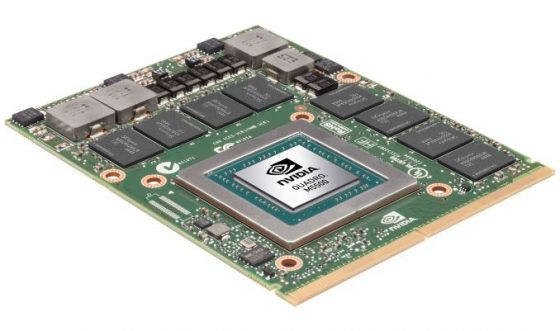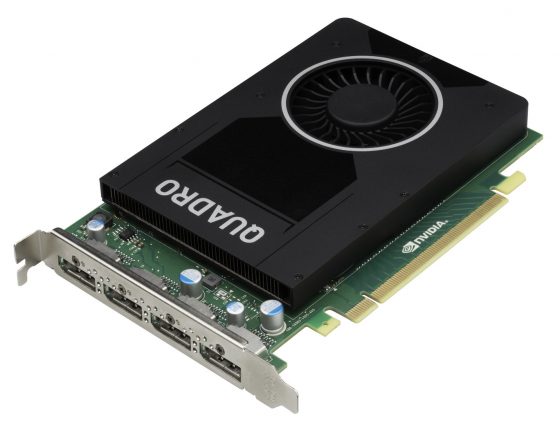One for the road and one for the desk.
By Alex Herrera
Nvidia’s GPU Technology Conference (GTC) has in the past been a forum to launch a new line of Quadro brand professional GPU products. And while we this year we saw the official unveiling of the next-generation Pascal chip (the GP100), we didn’t see any major revamp of Quadro. That wasn’t a huge surprise, as the company times its launches more in conjunction with Intel’s release of new workstation platforms. But that didn’t mean there were no new products at all, as Quadro did see two new noteworthy additions to the lineup: the Quadro M2000 for desksides and the Quadro M5500 for mobiles.
The VR-inspired M5500
The latest and greatest of Nvidia’s mobile Quadro line is the M5500. Based on the same GM204 GPU powering both the deskside and mobile Quadro high ends, the M5500 starts with the specs of the former top of the mobile heap, the M5000M, and builds from there. The new M550 provides more active CUDA cores (the full 2048 of the GM204) paired with faster memory.
Among all other applications for which the M5500 would undoubtedly be useful, Nvidia positioned VR as a key driving use case for the new Quadro SKU. From a technical perspective, that makes a lot of sense. The new M5500 steps up from the former top of the mobile Quadro heap, the M5000M, delivering higher performance for both compute and memory-bound rendering, making it highly desirable to satisfy VR’s demand for dual left-right stereo rendering. It’s built with 33% more CUDA cores for compute, paired with about the same increase in memory bandwidth.

Of course, there’s no free lunch when it comes to increasing performance. Something’s gotta give, and it’s usually power. Yes, engineers are constantly looking for ways to trim power, but with the same techniques employed, a higher performing version will burn more watts than the lower performing version. And in this case, with the M5500M based on the same GM204 GPU as the M5000—though with more CUDA cores and memory, both clocked faster—the M5500 worst-case power climbs to a lofty 150 watts, representing a 50% power adder to provide that (roughly) 33% performance gain.
Clearly, that’s not the power draw that many mobile workstation batteries can tolerate for too long, making the M5500 not the GPU for all. Rather, it’s the mobile GPU only for those who absolutely must have the highest performance possible on a mobile machine.
Mobile for virtual reality
At first, we wondered why Nvidia would go out of its way to position virtual reality (VR) on mobile workstations. After all, if convincing VR demands maximum performance, wouldn’t it make more sense to leverage the all-out performance of a high-powered deskside tower? Well, from the perspective of technology, that might make sense, but from the perspective of the applications, it’s quite possible that mobiles make the more compelling VR platforms.
Consider some of more persuasive arguments we’ve heard for implementing VR in professional applications. Most benefit from portability. Bringing an immersive architectural walkthrough to a client’s office, or bringing that surgical room preview to the hospital so doctors and nurses can give it a test drive and blessing. Nvidia isn’t the only one who is looking at VR from the mobile perspective. The platform that showcased the M5500 at launch was MSI’s new WT72 mobile, a “VR Ready” machine looking to target a range of VR usage for the road.
The last Maxwell refresh: the Quadro M2200
Product lines like Nvidia’s Quadro don’t tend to be refreshed in one fell swoop. Rather, a new generation of GPU technology, most recently Maxwell, typically creeps into the line over time. Often, that gradual overhaul starts at the top and trickles down, with the high end being most appropriate for the latest and greatest parts, which also tend to be the costliest.
Heading into GTC, Nvidia’s deskside line of Quadro GPUs were all based on Maxwell technology, with one exception: the midrange Quadro K2200, still based on previous-generation Kepler technology. As such, it didn’t take much in the way to envision a Maxwell successor for the K2200 shortly. And that’s what we got at the conference, with Nvidia unveiling the new Maxwell-based M2000 (Nvidia’s SKU-numbering places a prefix of the generation in front, “K” for Kepler, “M” for Maxwell).

This time, it was the mid-range that was last to be refreshed with next-generation silicon, but not because it’s the least important. On the contrary, the mid-range segment the M2000 targets is arguably the most lucrative segment for Nvidia. In fact, the Quadro M2000’s predecessor, the K2200, was hands-down the largest revenue-producing Quadro SKU for Nvidia, at a JPR-estimated $100 million (calibrated to retail price levels). With a sizable bump in both compute and memory performance, it’s likely the M2000 will continue that trend and carry a heavy volume load for Quadro over the next 18 months or so.





